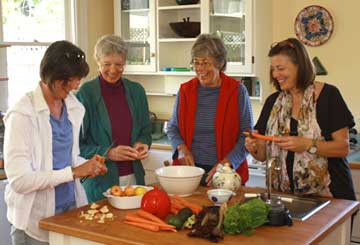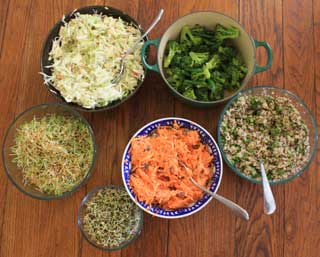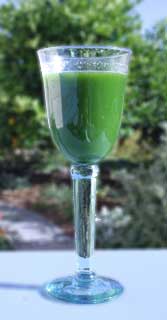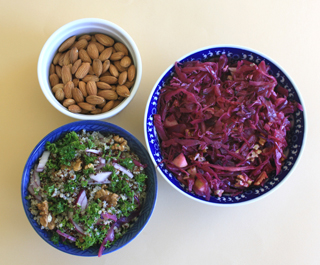A Healing Diet
by Ian Rawlinson
DIET
What we eat has changed more in the last one hundred and fifty years than in the previous 5,000 years. There is a substantial amount of research showing conclusively that many chronic illnesses that are so common today are caused by the current western diet. If you have a chronic illness, it is very likely that it is caused by, or at the very least exacerbated by, what you are eating. There is also a high probability your diet is also preventing you from being able to recover and heal.
The list of diseases and illnesses closely linked with diet include the major killers as well as others that have a huge impact on our lives. They include:
|
Cancer
Heart disease
High blood pressure
Diabetes
Arthritis
|
Depression
Asthma
Headache
Allergies
Fatigue
|
Fortunately, it is possible to change our diet and improve our health, and the purpose of this article is to give you some guidelines about how to implement healthier choices. This may seem very daunting, most of us are very attached to what we eat, but it is possible to make substantial changes and the benefits are enormous.
UNDERLYING PRINCIPAL

The underlying principle of this diet is to primarily eat foods that are easy to assimilate and need the minimum amount of processing by our digestive organs, particularly the liver and kidneys. By limiting foods in this way, we give our organs a chance to eliminate toxins that may have accumulated over a period of time. These poisons can inhibit the natural functioning of all the major organs causing the wide range of illnesses listed above. But it is not only these organs that benefit, every cell in our body is helped, because the cells also need very specific conditions in order to be able to function effectively. This diet helps us at a cellular level, and can reset cellular function.
The recommended foods include whole foods, 80% organic vegetables, with small quantities of protein and carbohydrates.
DETOXIFICATION
Our body is constantly processing and eliminating toxic substances. Some of these are the result of the normal metabolic functions of the body, while others may be foreign substances we absorb in various ways. Our environment is full of toxic chemicals -- not only pesticides that we consume in our food, but also in the air we breathe. A lot of the food in our typical diet is also full of other chemicals and substances such as dyes and preservatives. The accumulated effect of this causes the detoxification functions of the body, especially the liver, to become overloaded, and in time this impairs its ability to function effectively.
RANCID FOODS and COOKED OILS
All fats eventually become rancid with exposure to air and heat. This happens through poor storage, and also when using oils in cooking. (See later in this article, how to dry sauté (cook without heating oil.) The chemical bond within the oil is broken down. This transforms even healthy oils into food that is treated as a toxic substance by the body. Cells can be damaged by the free radicals that are created, and the liver is recruited for the detoxification process.

Nuts, seeds and oils are common foods that are vulnerable. Some oils and nuts go rancid very easily, and generally should be avoided. Even a high quality brand cannot guarantee how their food was shipped and stored.
Almonds and olive oil are recommended over other types of nuts and oils, because they are more stable than others,. Once purchased, these foods should be carefully stored, away from heat, light and oxygen. Food prepared in restaurants is often made without much thought to the state of the oil.
The taste should be fresh and sweet. Unfortunately, so many of the oil-bearing foods we eat are slightly rancid that rancidity is a taste many people have unknowingly become accustomed to.
ACID-ALKALINE
One major aspect of good health is dependent on the ability that our body has to maintain a balance of acid and alkaline in our tissues. When we cannot maintain this equilibrium, there are very serious repercussions to our health. Many factors influence this acid-alkaline balance, but one of the most important is what we eat. This is particularly true if we habitually eat too many acidic foods. The typical modern diet with its emphasis on meats, processed foods and sugars is very acid and is the cause of much illness. One aspect of this diet is to shift the emphasis away from acid foods and to eat a more alkaline diet.
RECOMMENDED FOODS
Alkaline foods
Including more alkaline foods in your diet can help correct an underlying imbalance that may have been caused by years of eating a diet that is too acidic. Vegetables, nuts, and sprouted legumes are alkaline foods and these foods form the basis of the recommended diet.
Many pathological microbes thrive in an acid environment. If your diet is composed predominately of acidic foods, the chemical environment of your cells, tissues and some organs will be well suited to these harmful microbes. This is particularly true for the intestines and the effects of this on our health can be severe.
Grains
Grains play a big part in most peoples' diet, with wheat being the most commonly eaten grain, so making a change is a big step. Grains that are recommended are quinoa, oats, millet and amaranth. None of these have gluten and are easier to digest.
Quinoa is an excellent food. High in protein, easy to digest and it cooks in 15 minutes! It doesn't have a lot of flavor, so adding fresh herbs and nuts or seeds, such as chopped almonds or chopped pumpkin seeds add a taste and texture.
Oats
If you are eating oats make sure they are steel cut or rough, rolled oats. Instant oats are more processed and do not contain the benefits of the less processed types.
Oils
I recommend only using extra virgin olive oil. Olive oil is a very stable oil, meaning it is less likely to go rancid than many other kinds. You can add a spoonful of oil to soups or other dishes just before you eat them. Avoid nut and seed oils as they very easily turn rancid.
Sprouts
Sprouts are an excellent source of protein. They can be bought at many stores or you can make your own. Go to: lisasfoods.com, to get directions on how to make them yourself.
Nuts and Seeds
Many nuts and seeds become rancid very easily so we recommend eating only almonds and pumpkin seeds. These can be chopped up and added to dishes. Store nuts and seeds in your refrigerator.
As far as is feasible eat only organic foods
|
Asparagus
Beets
Broccoli
Cabbage
Carrots
Celery
Cucumber
Daikon
|
Ginger (fresh)
Green beans
Lettuce
Oats
Olives (fine if they are cured in salt water, but not in oil)
Olive oil
|
Peas
Quinoa
Radish
Zucchini
Sea salt (Celtic )
Tahini (home made is best)
Almond butter (home made is best, but some health food stores make their own on the premises)
|
WHAT TO AVOID
What follows may seem a bit daunting, but the items listed below are most likely contributing to your feeling unwell, so as far as is possible avoid them.
Packaged and Processed Foods
All packaged and processed foods. The typical modern diet includes a lot of highly processed foods. Processed foods have a lot of negative effects and are not included in this diet. This includes anything that is packaged, such as pasta, tinned foods, frozen foods and bottled foods, as well as baked foods such as breads, cookies and pastries.
Sugar
Eliminating sugars can be a very important step to regaining good health. The average American now consumes 122 lbs. of sugar a year! Sugar is a very acid food and provides the ideal environment for many harmful diseases to thrive. Recent research has shown that cancer tumors use glucose to grow, and completely eliminating sugars from the diet helps reduce the ability of tumors to develop. Sugar, any type of sugar, should be avoided, including honey, agave, and maple syrup.
Nightshade Vegetables
Avoid the nightshade family: eggplant, tomatoes and red and green peppers. Most varieties of potatoes should be avoided, but red potatoes can be included in your diet.
Spices
Stop using spices, including pepper, and flavor your food with fresh herbs.
Nuts
A lot of nuts go rancid very easily and this causes extra work for our bodies, especially the liver. It is best to avoid most nuts such as walnuts, brazil, hazel and cashews. Almonds are usually fine, but make sure you get nuts that have been stored properly and keep the ones you buy in your freezer.
Cooked Oils
Heated oil is hard for the body to digest. Uncooked oil can be added to dishes just before they are eaten, soups in particular taste a lot better when this is done.
Beans & Legumes
For the first three to nine months stop eating cooked legumes, such as beans and lentils. As has already been mentioned, sprouted seeds and beans are fine.
Meat
Meats, including fowl and fish.
Dairy
Avoid all dairy produces, especially cheese. The exception is yogurt, which can be eaten in small quantities.
Gluten
Gluten is a protein found in many grains such as wheat, barley and rye. It is not an easy substance for your body to assimilate, which is why it should be eliminated from your diet.
Caffeine
Caffeine should be avoided, especially, coffee. A little green tea is all right now and then.
Avoid these foods:
|
Caffeine
Cheese
Chicken
Chocolate
Canola oil
Cooked oil
Eggs
Eggplant
|
Fish
Honey
Meat (red)
Mushrooms
Pasta
Red pepper
Green pepper
|
Sea vegetables
Spices
Sugar
Tamari
Vinegar
Chilled foods from the
refrigerator
Ice in drinks
|
PREPARING YOUR MEALS
Dry Sauté
Dry sautéing is cooking without oil. Instead of heated oil, vegetable broth or water is used. It is easy to learn how to cook this way. The trick is to use only a little liquid. First, heat the pan for a minute or so, and then add the vegetable you want to cook. If you are sautéing an onion, you can let it brown a little bit and then add a liquid (either broth or water) and stir in the brown parts until all the moisture is absorbed. This carmelization adds a lot of flavor to the food. Once the onion is cooked, add any other vegetables and continue stir-frying, adding small quantities of liquid as needed, but keep it to a minimum. If you add too much liquid you end up simply steaming the vegetables. Once the dish is cooked, a little oil can be stirred in just before eating.
Vary Cooking Method
Vary the way you cook your vegetables. They can be steamed, grilled or baked, but when you grill, braise or bake them do not use oil!
Texture
This diet can be a bit bland, so one way to make it more interesting is to vary the texture of the ingredients. Vary the length of time you cook your vegetables so that some days they are only lightly cooked. Adding chopped nuts and seeds helps create more interesting dishes.
Eat Seasonally
Up until the last 70 or 80 years most people ate foods that were grown locally, and fresh foods were eaten seasonally. With the advent of refrigeration it is now possible to eat just about any food at any time of the year. Shopping at local farmers' markets will give you a better idea of what is in season and also what is being grown in your area.
SNACKS

Most of us like to have a snack at some point during the day. Carrot or celery sticks are a good choice. They can be made up in the morning so they are ready when you want them. Almonds can also be eaten between meals.
JUICED GREEN DRINK
This green drink is very alkaline and is a very good way to start your day. Wash the vegetables and then juice and use equal quantities of each vegetable. Drink one 8 oz glass per day; the best time is in the morning on an empty stomach.
Cucumber
Celery
Zucchini
Romaine lettuce
If the vegetables have been stored in the refrigerator, let them warm up to room temperature before drinking.
A TYPICAL MEAL
On this diet many of your main meals will consist of several different vegetable dishes. Perhaps a quinoa salad, fresh green salad and a cooked vegetable dish. It is possible to create a tasty, interesting menu and even though the ingredients you use may be limited, there is room for a lot of variety. Your meals can be appealing, satisfying and enjoyable!
RECIPES
Quinoa
2 cups of water
1 cup quinoa
¼ teaspoon salt
Bring the 2 cups of water to the boil. Add salt and quinoa and bring to boil, and then cover and turn heat to simmer. Cooks in 15 minutes!
Quinoa Salad
2 cups of cooked quinoa
¼ cup of chopped walnuts
¼ cup of chopped pumpkin seeds
½ cup finely chopped parsley
Juice of 1 lemon
Put the quinoa in a bowl and add the other ingredients and stir.
Dressings
With a more limited selection of foods it's important to be creative and make your meals tasty and interesting. One way you can do this is by varying the dressing you use.
A good basic dressing is:
lemon juice
olive oil
Celtic sea salt
1 clove of garlic
To this you can add fresh herbs and other ingredients such as:
|
Parsley
Cilantro
Basil
Rosemary
|
Oregano
Marjoram
Thyme
and/or Tahini,Yogurt
|
Of course the amount you add will vary according to taste, but I find adding ¼cup to 1 cup of fresh herbs to the dressing is usually about right. More than one herb can be used.
Cooked Red Cabbage Salad 
1 small red cabbage (about 18 oz.)
1 clove garlic, finely chopped
2 tablespoons garlic, finely chopped
2 tablespoons olive oil
1 red onion, quartered & thinly sliced
1 tablespoon parsley, chopped
½ teaspoon marjoram, finely chopped
½ cup chopped almonds
Quarter the cabbage and remove the core. Cut the wedges into thin pieces, 2-3 inches long, and set them aside. (I use a bread knife, and really shave thin slices off the cabbage.)
Dry sauté the onion and the garlic until they go limp (add a little water if needed). Then add the cabbage and continue to cook, stirring it with a pair of tongs for approximately 2 minutes or until just wilted. The leaves will begin to soften and the color will change from bright purple-red to pink. Season with salt, oil and lemon juice to taste. Then add the herbs and almonds. Toss briefly before serving.
Butternut Squash Soup
2 cups butternut squash
2 cups carrots
2 cups parsnips
Vegetable broth or water
Place vegetables in a saucepan and cover with broth or water. Bring to boil and then simmer until vegetables are cooked. Pour ingredients in a blender and add a little salt and blend.
IMPLEMENTING CHANGES
Each one of us approaches life in an unique way. Some of us like to make changes slowly; others like to do things all at once. However you may choose to make changes in your diet, I recommend you set a time limit of six weeks, observe the effects of the changes and then reevaluate again after a six week period.
Making and sustaining the changes recommended here is not an easy undertaking, but the benefits are enormous. Once your system has had a chance to heal, and you are stronger and more vital, you can be more flexible with what you eat.
This is not necessarily a regime you will have to strictly follow forever! You just need to follow it strictly until you regain your health. Then you can include some other foods and have a more flexible, maintenance regime.
I know from my own experience just how difficult it can be to make substantial changes to one's diet. I also know just how beneficial it is to eat a simple and healthier diet. Changing what we eat, in conjunction with other healing modalities, can turn around the very bleak situation of poor health. Good health is the foundation of leading a fulfilling and vibrant life, so I encourage you to seriously rethink what you are eating, and see the benefits you will get from implementing these suggestions.
Ian Rawlinson
Acknowledgements
Much of the material described here is based on the work of James Reese. It also draws on the work of Dr. Randolph Stone, renowned naturopath and chiropractor and the founder of Polarity Therapy.
Other Articles:
|